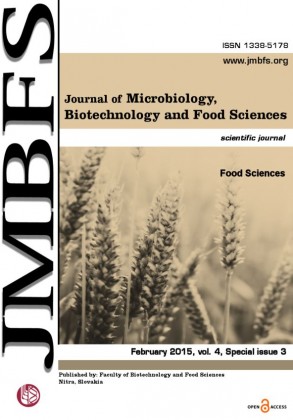OXIDATIVE STABILITY OF CHICKEN MEAT AFTER APPLICATION PHYTOGENIC ADDITIVES IN THEIR DIET
DOI:
https://doi.org/10.15414/jmbfs.2015.4.special3.14-17Keywords:
Phytogenic additives, chicken meat, oxidative stabilityAbstract
The aim of the study was to evaluate the oxidative stability (TBARS method) of breast and thigh muscle after application of feed mixtures enriched by phytogenic additives. The experiment started with 250 pieces one-day-old chicks of Cobb 500 hybrid combination. They were divided into one control (C) and four experimental groups (1st EG, 2nd EG, 3rd EG, 4th EG). Each group included 50 chicks. In experimental groups, feed additives were applied as followed: 100 mg kg-1 Agolin Poultry (in the 1st EG), 500 mg kg-1 Agolin Tannin Plus (in the 2nd EG), 1000 mg kg-1 Biostrong 510 + FortiBac (in the 3rd EG) and 1000 mg kg-1 Agolin Acid (in the 4th EG). We recorded positive influence on chicken meat oxidative stability in all experimental groups with application of plant feed additives. Experimental broiler chickens were fed during 42 days by ad libitum. Chicken meat samples of breast and thigh muscle were analyzed in the 1st, 3rd, 5th and 7th day of storage in cold conditions at 4 °C. Obtained results showed that applied phytogenic additives had positive influence on oxidative stability of breast and thigh muscles. At the end of cold store (in 7th day), we found higher malondialdehyde (MDA) values and lower oxidative stability (P<0.05) of breast muscle in control group (0.157 mg kg-1) compared to experimental groups (from 0.124 mg kg-1 in the 3rd EG to 0.133 mg kg-1 in the 1st EG). In the thigh muscle, we found similar tendency of oxidative changes as in the breast muscle. At the end of cold store (in the 7th day), MDA average values of thigh muscle were higher (P<0.05) in control group (0.179 mg kg-1) compared to experimental groups (from 0.136 mg kg-1 in the 4th EG to 0.141 mg kg-1 in the 1st EG). Significant differences (P<0.05) between the control and experimental groups were found from the 5th day of storage in thigh muscle in contrast to breast muscle. Obtained results indicate positive influence of phytogenic additives applied in chicken nutrition, namely on stabilization of fatty substance to degradation processes.Downloads
Download data is not yet available.
Downloads
Published
2015-02-02
How to Cite
Bobko, M., HaÅ¡ÄÃk, P., Tóth, T., Kňazovická, V., Mellen, M., Bobková, A., & TkáÄová, J. (2015). OXIDATIVE STABILITY OF CHICKEN MEAT AFTER APPLICATION PHYTOGENIC ADDITIVES IN THEIR DIET. Journal of Microbiology, Biotechnology and Food Sciences, 4(special issue 3 (Food Sciences), 14–17. https://doi.org/10.15414/jmbfs.2015.4.special3.14-17
Issue
Section
Food Sciences
License
Copyright (c) 2015 Marek Bobko, Peter HaÅ¡ÄÃk, Tomáš Tóth, VladimÃÂra Kňazovická, Martin Mellen, Alica Bobková, Jana TkáÄová

This work is licensed under a Creative Commons Attribution 4.0 International License.
All papers published in the Journal of Microbiology, Biotechnology and Food Sciences are published under a CC-BY licence (CC-BY 4.0). Published materials can be shared (copy and redistribute the material in any medium or format) and adapted (remix, transform, and build upon the material for any purpose, even commercially) with specifying the author(s).





